A Crossroad of Civilizations in the Mediterranean
2021/11/19
Catania, Italy
The island of Sicily in southern Italy is home to many historical sites, beautiful cities, and abundant nature. The Italian mainland is in the shape of a boot, and Sicily is located just beyond the toe of the boot, almost in the center of the Mediterranean Sea. Starting with the ancient Greeks who laid the foundation of the island, it has been a crossroads of civilizations. Several powers have intersected since as far back as 3,000 years ago, including the Roman Empire, the Byzantine Empire, the Muslims, and the Kingdom of Spain. Even today, the culture that remains intact is full of brilliance. In the warm Mediterranean climate, the beautiful sea and the rich food culture blessed by nature attract people to visit Sicily.
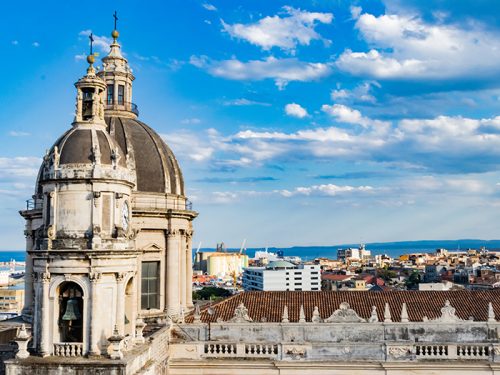
A World Heritage City with Mount Etna
Catania, the port of call for the ship, is a city built on lava that flowed from Mount Etna, the largest active volcano in the Mediterranean. The name “Catania” is derived from the early Greek name “Katane” (meaning “land of lava”). Since prehistoric times, the city has been hit by numerous natural disasters, but it has always come back strong.
The magnificent Baroque towns that can be seen today were rebuilt over a period of 100 years after the eruption of Mount Etna and the great earthquake in the late 17th century. The beautiful towns scattered across the southeastern part of Sicily, including Catania, are registered as a UNESCO World Heritage Site as “Late Baroque Towns of Val di Noto.”
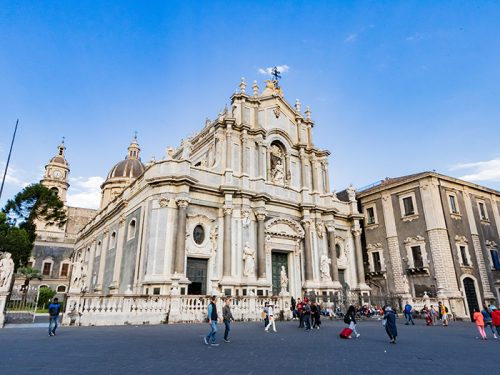
In addition to the Baroque buildings, Catania also has many ruins from the Roman Empire, such as the Roman theater and amphitheater. As you explore the city, you will be surrounded by the mysterious scenery of different eras living together.
In the center of the city, in the Piazza del Duomo, stands the Catania Cathedral, dedicated to Agatha, the patron saint of the city. The cathedral was first built in the 11th century, but after the earthquake in the 17th century, it was rebuilt in the Baroque style, which is what it looks like today. The pillars and walls of the exterior look darker because of the lava from Mount Etna that was used in the reconstruction. This is a spot that tells the history of Catania, where you can feel up close how the past is passed on without being destroyed.
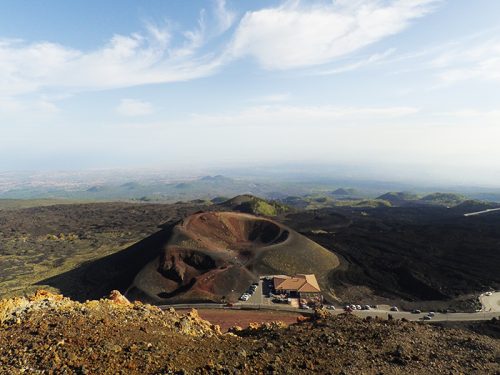
Hiking on Mount Etna, a World Natural Heritage Site
Behind the city of Catania rises Mount Etna, the largest active volcano in the Mediterranean. While this mountain is known as one of the most active volcanoes in the world, its eruptions are very mild and small eruptions are a common sight. The volcanic ash produced during the eruptions contains many minerals. This provides nature’s bounty to a variety of crops such as wine grapes, pistachios, and olives. Hiking on Mt. Etna is also a popular activity to experience the natural beauty of Sicily. We took the ropeway and a four-wheel drive minibus to the top of the mountain. The view of the huge crater is breathtaking. You can feel the heartbeat of an active volcano.
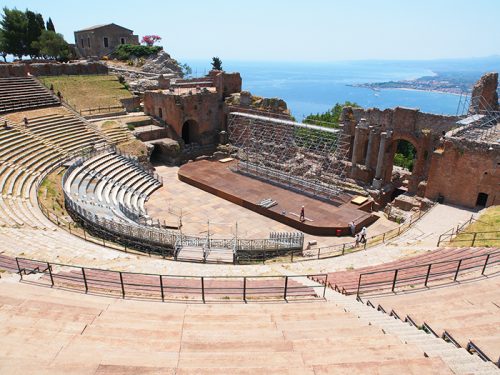
To the Stage of “Le Grand Bleu”
Taormina is one of Italy’s most exclusive resorts, known as the location for the French-Italian co-production “Le Grand Bleu” released in 1988. The town is located on a plateau 200 meters above sea level, and the scenery is just as it was in the movie. The Teatro Greco, an ancient Greek open-air theater built in the 3rd century B.C., is one of the most famous spots where you can see the beautiful panorama. The mortar-shaped stage, carved out of a rocky slope, is still used for outdoor concerts and plays. If you sit on the upper tier of the audience seats, you can enjoy a spectacular view of the deep blue Mediterranean Sea and Mount Etna.
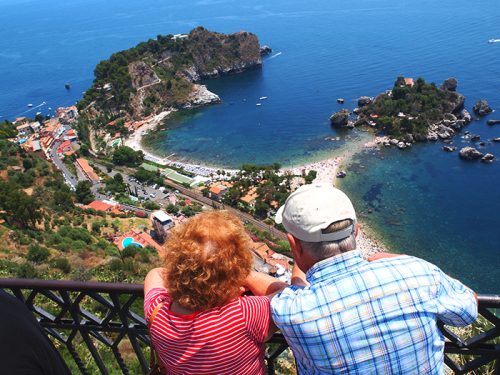
When you visit Taormina, you must also experience the beautiful Sicilian sea. The clear cobalt blue waters of the Gulf of Isola Bella spread out below the city of Taormina. Isola Bella means “beautiful island” in Italian. As the name suggests, there is a small island in the middle of this cove connected to the coast by a narrow shallow channel. The island was originally the property of a noble family, but is now owned by the state of Sicily and is treated as a natural and cultural heritage site. In the summer, the beach is lined with parasols and a vacation atmosphere is created as many people enjoy sunbathing on the beach.
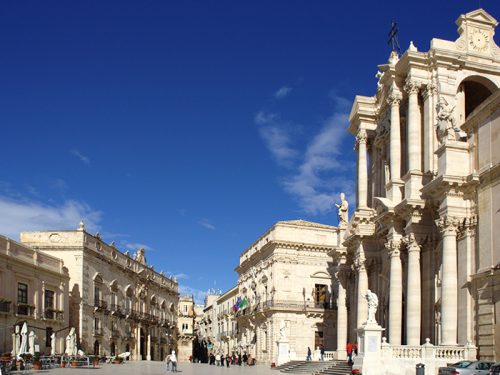
One of the Most Beautiful Towns in Sicily
In the ancient Greek and Roman periods, Syracuse flourished as a major city along with Athens. It is also known as the setting for renowned Japanese writer Osamu Dazai’s novel, “Run! Melos”, as well as for giving birth to the famous mathematician Archimedes.
The city of Syracuse is divided into the New Town and the Old Town. The new town has a Greek theater and altar, as well as remains of a Roman amphitheater, while the old town is spread out on the island of Ortigia, which juts out from the tip of the city. The Piazza del Duomo, located in the center of the old town, is sometimes referred to as “the most beautiful square in Sicily.” Strolling through the open marble streets under the piercing blue sky typical of Sicily, you will be able to enjoy the glory of the past.

Taste the best of Sicily
When you visit Sicily, you can expect to encounter gourmet food that is richly blessed by the Mediterranean. In addition to fresh seafood, the vegetables and fruits grown in the strong Mediterranean sunshine are also rich in flavor. Pasta with sardines, carpaccio of swordfish tuna, grilled eggplant and tomatoes, and many other dishes that make the most of the flavors of the ingredients are all excellent.
Arancini, a rice croquette known as a local dish in Sicily, is another must try. The crispy batter is filled with rice cooked like risotto. Just a bite will surely make you fall in love with it.
PHOTO: PEACEBOAT, Isogai Miki, Masagaki Naoto
